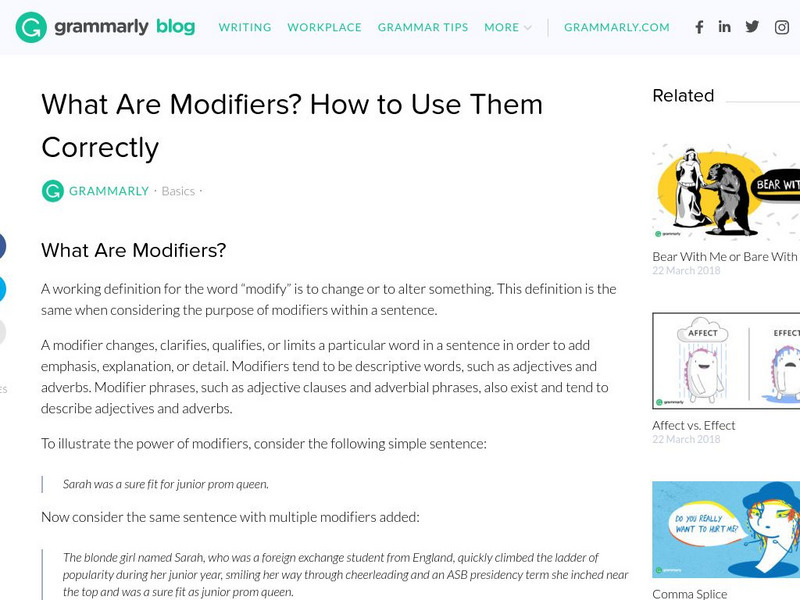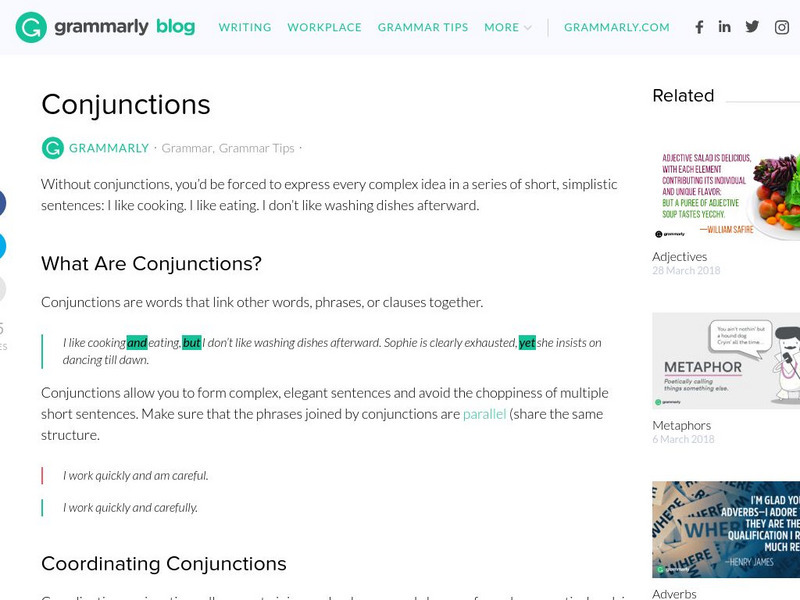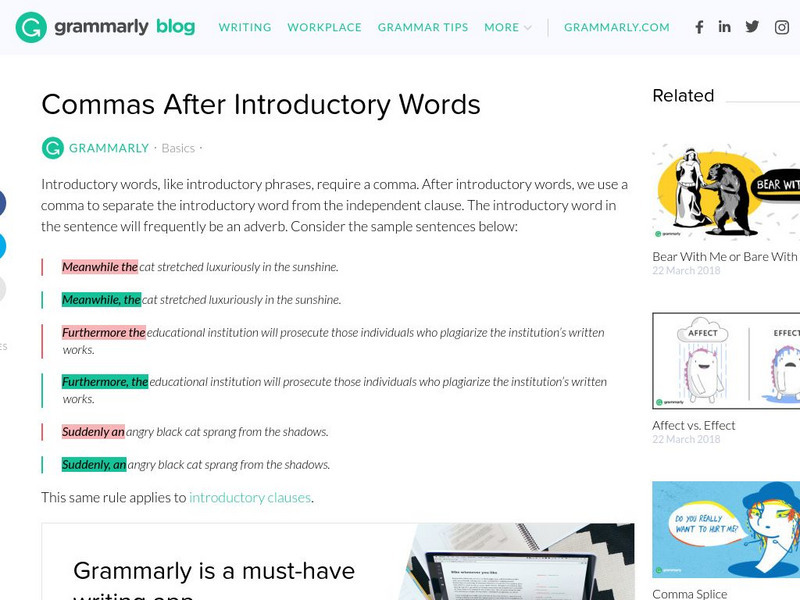Grammarly
Grammarly Blog: Common Errors in English: Good or Well
This Grammarly Handbook resource clarifies the difference in usage between "good" and "well" in sentences. Numerous examples are provided in this resource.
Grammarly
Grammarly Blog: Present Perfect Continuous(present Perfect Progressive)tense
An explanation with examples of present perfect progressive verb tense in sentences.
Grammarly
Grammarly Blog: With Sense Verbs
This page explains the use of adverbs and adjectives with verbs of the five senses and provides examples.
Grammarly
Grammarly Blog: Quotation Marks Setting Off Specific Words or Terms
Rules and examples for using quotation marks to set off specific words within a sentence.
Grammarly
Grammarly Blog: Parallelism With Prepositions
An explanation with examples of using parallel structure with prepositions.
Grammarly
Grammarly Blog: Unnecessary Comma in a Complex Sentence
Rules and examples for using commas when writing a complex sentence.
Grammarly
Grammarly Blog: Adjective and Verb Placement
This page focuses on the relationships between adjectives and verbs including predicate adjectives, linking verbs, and participles --verbs used as adjectives such as the smiling baby.
Grammarly
Grammarly Blog: Capitalization: Periods and Events (Not Century Numbers)
This page explains that historical periods and events are capitalized as proper nouns, but centuries are not. Examples are provided.
Grammarly
Grammarly Blog: Connecting Sentences
This Grammarly Handbook resource provides ways to connect sentences using transition words and punctuation (colons and semi-colons). Includes a list of transitional words and their uses, and a discussion of how punctuation is used to...
Grammarly
Grammarly Blog: Present Perfect Tense
An explanation with examples of present perfect verb tense in sentences.
Grammarly
Grammarly Blog: Pronoun Reference
An explanation with examples of pronouns and how they are used in sentences.
Grammarly
Grammarly Blog: Prepositions of Direction
An explanation with examples of prepositions that describe direction.
Grammarly
Grammarly Blog: Comma Setting Off Non Restrictive Clauses
This page focuses on understanding what a non-restrictive clause is and that it must be set off by commas. It explains that non-restrictive clauses often use begin with the word "which" and offers examples.
Grammarly
Grammarly Blog: Spelling Plurals With S or Es or Other Plurals
Spelling rules and examples for adding -s or -es to make the plural form of a word.
Grammarly
Grammarly Blog: Semicolon With Conjunctions
Rules and examples for using semicolons with conjunctions in a compound sentence.
Grammarly
Grammarly Blog: Capitalization: The First Word in a Direct Quote Sentence
This page explains the rules for capitalizing direct quotes; if the quote is a sentence, capitalize it. If the quote is not a complete sentence, capitalize only what was capitalized in the original direct quote.
Grammarly
Grammarly Blog: Parallelism
A list of ten situations where writing should be parallel. Each contains a link to additional information.
Grammarly
Grammarly Blog: What Are Modifiers? How to Use Them Correctly
This page focuses on modifiers including what modifiers are -- adjectives, adverbs, and descriptive phrases and clauses; misplaced modifiers and how to correct them; and limiting modifiers and how to use them. Examples are provided.
Grammarly
Grammarly Blog: Blog: Adverbs: What Do Adverbs Modify?
This blog focuses on adverbs, including what they modify, how to find them in sentences, degrees of adverbs, and examples of each.
Grammarly
Grammarly Blog: Intensive Pronouns
An explanation with examples of intensive pronouns and how they are used in sentences, as well as how they differ from reflexive pronouns.
Grammarly
Grammarly Handbook: Evaluating Resources
This page explains the need for evaluating resources and offers links to rules for evaluating primary, secondary, or tertiary resources and determining if resources are good or bad.
Grammarly
Grammarly Blog: Conjunctions
This page focuses on conjunctions including what conjunctions are; the types of conjunctions: Coordinating, Correlative, and Subordinating; how to start sentences with conjunctions, examples of each of the above, and lists for each type...
Grammarly
Grammarly Blog: Commas After Introductory Words
This Grammarly Handbook resource explains how to use commas after introductory elements. Numerous examples of commas after introductory phrases, introductory clauses, and introductory transitions are provided in this resource.

























